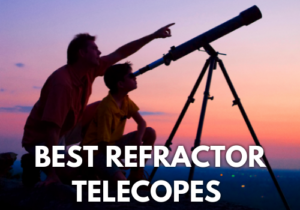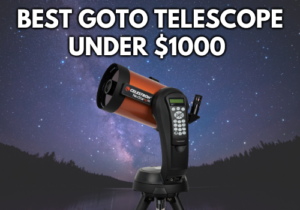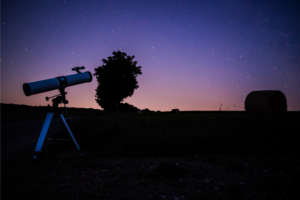7 Best Telescopes To See Jupiter & Its Moons 2026; Reviews
Disclosure: This post contains affiliate links and I may earn a small commission (at no extra cost to you) if you click through and make a purchase. Thanks in advance – I really appreciate it!
Here in this “Best Telescope To See Jupiter & Its Moons” article we’ve rounded up 7 of the best telescopes of various types, specifications, and budget perfectly suitable to view Jupiter’s Moons. Below, you’ll find in-depth reviews of each, as well as an elaborate buying guide to help you pick out the one that suits you the most.
Our Top 3 Picks
When is the best time to observe Jupiter in a telescope?
At the beginning of every January, Jupiter is usually best observed at the end of the night and before the sun rises. Over the following months, the planet will gradually show up earlier and earlier in the night sky. In the northern hemisphere, you should be able to see Jupiter in a telescope from 11 pm.
The best time to view Jupiter through your home telescope is when it is at opposition from the sun in the sky (from our point of view). This means that Earth & Jupiter’s orbit briefly “sync” up on the same side of the sun.
When this happens, Earth is positioned directly between Jupiter and the sun, which gives amateur astronomers the perfect angle to observe the planet. Thanks to its proximity to our planet, Jupiter will appear a lot brighter and will allow for great seeing.
Best Telescope To See Jupiter
With so many models with so many features available today, it can be a tedious task to find the best telescope to see Jupiter. We have analyzed the main features ( aperture, focal length, ratio, portability, affordability etc.) that make a good telescope for viewing planets that you can use to enjoy the night sky and fulfill your love for astronomy.
1. Celestron NexStar 6SE
- ADVANCED TECH MEETS ICONIC DESIGN: The NexStar 6SE pairs Celestron’s legendary orange tube with a fully computerized GoTo system—ideal for those ready to step up from manual scopes and explore more of the night sky with precision and ease.
- 6-INCH SCHMIDT-CASSEGRAIN OPTICS: The large 6" aperture gathers enough light to reveal fine lunar details, cloud bands on Jupiter, and deep-sky objects like galaxies and globular clusters—all in a compact, portable form factor.
- FULLY AUTOMATED GoTo MOUNT WITH NEXSTAR+ HAND CONTROL: Use the NexStar+ hand control to select from a 40,000+ object database. The computerized mount then automatically slews to your target and tracks it—no star charts or manual alignment needed.
- FAST & EASY ALIGNMENT WITH SKYALIGN TECHNOLOGY: SkyAlign gets you observing fast—just center any three bright stars or planets, even if you don’t know their names. The system then calculates your position and aligns the mount in minutes.
- COMPATIBLE WITH CELESTRON ACCESSORIES: Easily upgrade your setup with all our latest accessories to enhance automation, wireless control, or location accuracy as your skills grow.
The Celestron NexStar 6SE strikes a great balance between performance and ease of use, making it a standout choice for both budding astronomers and experienced stargazers looking to upgrade.
Its 6-inch Schmidt-Cassegrain optical tube gathers plenty of light, so you’ll be able to see fine details on the Moon and planets like Jupiter — including its cloud bands and Galilean moons — under decent sky conditions. The optics are well-finished and the build quality feels solid, which helps deliver crisp, satisfying views of celestial targets.
What really sets this telescope apart is its fully computerized GoTo mount paired with SkyAlign technology. Instead of manually hunting for objects in the night sky, you simply align on any three bright objects and the telescope quickly figures out where it’s pointed — then automatically slews to targets you select from its database of over 40,000 stars, galaxies, nebulae, planets, and more.
This makes exploring the heavens far more accessible and enjoyable, especially for beginners who aren’t yet familiar with star charts.
No telescope is perfect, and some owners note that features like battery life (it runs on multiple AA batteries unless you add an external power source) can be a limitation during long observing sessions. However, the NexStar 6SE’s compact, portable form factor and upgrade-friendly design — compatible with accessories like StarSense AutoAlign and wireless controls — mean it can grow with you as your interests evolve.
For its combination of ease of use, impressive optics, and automated tracking, it remains one of the most recommended intermediate telescopes on Amazon.
2. Celestron – AstroMaster 130EQ
- POWERFUL TELESCOPE FOR ASTRONOMY BEGINNERS: The AstroMaster 130EQ delivers sharp optics, a stable equatorial mount, and smooth manual controls, making it the top choice for beginners ready to explore the night sky.
- HIGH-QUALITY 130MM OPTICS: Enjoy views through the 130mm (5”) Newtonian reflector, which features high-quality aluminum and SiO₂ coatings and enough light-gathering ability to view all the best celestial objects.
- SMOOTH, ACCURATE POINTING: Effortlessly aim and center your target using the two slow-motion control knobs for right ascension and declination whether you’re observing planets or deep-sky objects.
- QUICK SETUP: With just a few key parts to assemble, you can go from box to backyard in minutes—no tools required. The sturdy, adjustable tripod provides stable, comfortable viewing tailored to your height, perfect for adults or kids, standing or seated.
- INCLUDED ACCESSORIES: 20mm eyepiece with built-in erect image corrector, 10mm eyepiece, and a StarPointer red dot finderscope. You'll also receive a FREE download of one of the top-rated astronomy software programs.
The Celestron AstroMaster 130EQ is a classic beginner-friendly reflector telescope designed for anyone ready to explore the night sky with more power than a basic tabletop model.
At its heart is a 130 mm (5.1″) primary mirror that gathers plenty of light, letting you see just noticeable details on planets like Jupiter and its moons, Saturn’s rings, and bright deep-sky objects such as nebulae and star clusters. The optics are coated for improved brightness and contrast, delivering crisp views that are especially satisfying at moderate magnification.
Unlike simple alt-azimuth scopes, this model uses a German equatorial mount with slow-motion control knobs, allowing you to track celestial objects smoothly as the sky drifts by. While it’s fully manual — so you’ll need to learn basic mount alignment and manual tracking — the setup encourages learning the night sky and gives you fine control once you get the hang of it.
The package includes two eyepieces (typically 20 mm and 10 mm), a red-dot finderscope to help locate targets, and even a complimentary astronomy software download to plan your observing sessions.
Of course, there are some trade-offs at this price point. Because tracking and pointing are manual, beginners may find the equatorial mount a bit challenging at first, and some components like the focuser are not as robust as those on pricier models — so patience and practice go a long way.
Still, for its affordable price and solid optical performance, the AstroMaster 130EQ represents excellent value for newcomers who want meaningful views of planets and beyond without spending on computerized systems.
Related
3. StarSense Explorer DX 130AZ
- SMARTPHONE-POWERED SKY TOUR: No experience needed! Just dock your phone, launch the StarSense Explorer app, and follow the on-screen arrows to locate stars, planets, nebulae, and more.
- PATENTED STARSENSE TECHNOLOGY: Unlike other astronomy apps, StarSense Explorer uses sky recognition technology to turn your phone into a celestial navigation system, analyzing star patterns overhead to pinpoint your telescope’s position.
- TONIGHT’S BEST TARGETS, INSTANTLY: The app generates a curated list of the top objects to see based on your time and location. See planets, bright nebulae, galaxies, and star clusters from the city—and even more from dark skies.
- SIMPLE SETUP, SMOOTH TRACKING: Features a manual altazimuth mount with dual-axis slow-motion controls. Follow the on-screen arrows to your target; when the bullseye turns green, you can view it clearly through the eyepiece.
- 130MM REFLECTOR WITH IMPRESSIVE VIEWS: The 5" Newtonian reflector with high-reflectivity coatings delivers sharp, vivid views of the Moon, planets like Jupiter and Saturn, and deep-sky favorites like the Orion Nebula and Andromeda Galaxy.
The StarSense Explorer DX 130AZ brings a clever twist to beginner telescopes by combining a classic Newtonian reflector optical tube with smartphone-guided navigation.
Rather than relying on a traditional GoTo mount, it uses the StarSense Explorer app and your phone’s camera to recognize star patterns and guide you toward celestial objects, making it far easier to locate targets like Jupiter and its moons than with a purely manual scope.
Out of the box it includes two eyepieces and a stable alt-azimuth mount with slow-motion controls, and many users find the setup and alignment process intuitive — even if you’ve never pointed a telescope skyward before.
Once aligned with the app, the telescope performs well for its class. The 130 mm aperture gathers enough light for pleasing views of the Moon, bright planets, star clusters, and many deep-sky objects, and observers report crisp, contrasty images that reward patient viewing. The StarSense app’s plate-solving technology helps get targets into the eyepiece without hours of star hopping, which is a real boon for new stargazers who might otherwise struggle to find objects in the night sky.
That said, the included eyepieces are fairly low-power, so you’ll likely want additional higher-magnification eyepieces if you’re keen on detailed views of planetary features or the cloud bands and moons of Jupiter.
There are some trade-offs to be aware of. The mount is manual and doesn’t track objects automatically, so you’ll still need to make regular adjustments as celestial objects drift with Earth’s rotation; this can be a bit fiddly at higher magnifications. Additionally, because the system depends on your phone for navigation, battery life and app compatibility can influence your experience.
However, many owners find that the combination of easy star alignment, solid optics, and overall affordability makes this telescope a satisfying first instrument that can introduce you to serious sky-watching and inspire further exploration.
4. Celestron – PowerSeeker 127EQ
- PERFECT ENTRY-LEVEL TELESCOPE: The Celestron PowerSeeker 127EQ is an easy-to-use and powerful telescope. This 127mm Newtonian Reflector offers enough light gathering ability to see planets, the Moon's craters, distant stars, the Orion Nebula, and more.
- MANUAL GERMAN EQUATORIAL MOUNT: With its slow-motion altitude rod, the German Equatorial mount allows you to navigate the sky with ease. Find celestial objects quickly and follow them smoothly & accurately as they appear to drift across the night sky.
- COMPACT AND PORTABLE: The ideal telescope for adults and kids to use together, the PowerSeeker is compact, lightweight, and portable. Take it to your favorite campsite, a dark sky observing site, or simply the backyard.
- MULTIPLE ACCESSORIES: The Celestron PowerSeeker 127EQ Telescope comes with 2 quality eyepieces (20mm and 4mm) plus a 3x Barlow lens to triple the power of each. You'll also receive a FREE download of one of the top-rated astronomy software programs.
- UNBEATABLE WARRANTY & SUPPORT: Buy with confidence from Celestron, a leading telescope brand in California since 1960. Your purchase includes a 2-Year US Warranty and unlimited support from our team of US-based experts.
The Celestron PowerSeeker 127EQ telescope is a Newtonian reflector, which means it uses mirrors to gather the light of the skies, and reflects it for viewing. With mirrors being much less expensive to produce than glass lenses, reflector telescopes offer more value in terms of inches of aperture.
The PowerSeeker 127EQ comes with two eyepieces (4mm and 20mm) and a 3x Barlow lens.
The 5-inch mirror on the 127mm PowerSeeker model limits useful magnification to about 250x, which is achieved using the 4mm eyepiece.
The larger 20mm eyepiece provides a more useful 50x magnification. This grows to 150x when coupled with the 3x Barlow.
If you’re considering an additional eyepiece, something like a 15mm Plossi would be a good option. This provides you with 66x magnification, or 198 when coupled with the Barlow.
The telescope is ideal for near and deep-sky observation, Celestron’s PowerSeeker 127EQ 127mm f/8 Reflector Telescope features a respectable focal length and a large, parabolic mirror that produce detailed images of the Moon, clear views of the planets, and the ability to resolve bright distant objects such as nebulae and galaxies.
The beauty of a Newtonian telescope is the longer focal lengths which can be offered in much shorter tube sizes—1000mm focal length in a tube which is only 20 inches (508mm) long .
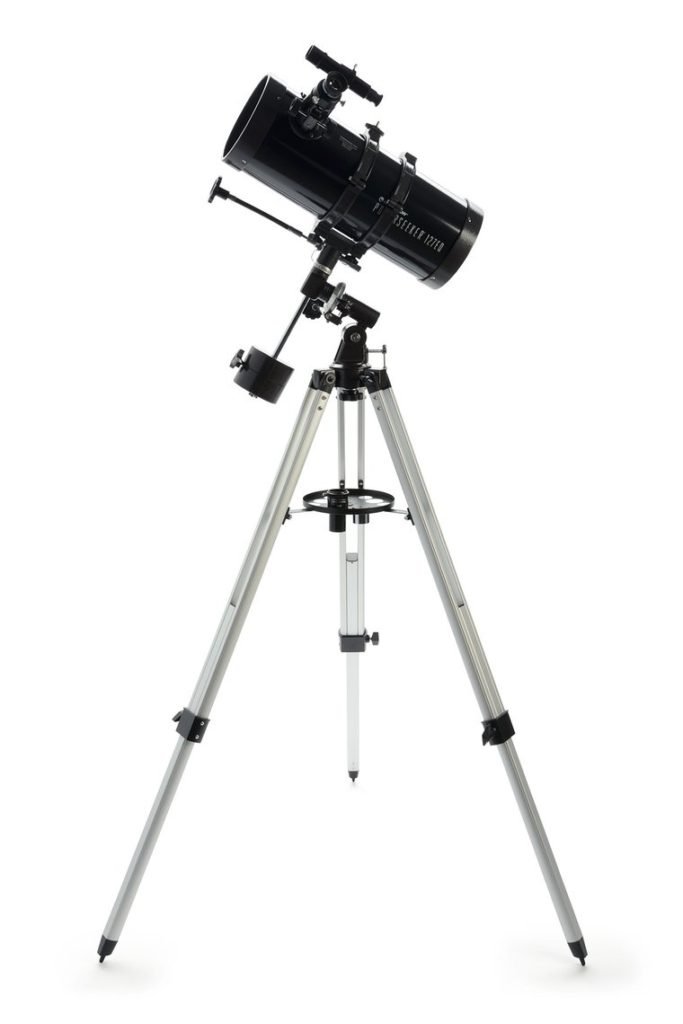
The PowerSeeker 127EQ is highly portable and one of the best telescopes to see Jupiter. You could easily fit this telescope and tripod in the trunk of a car and still have room for your other equipment, or maybe a late night picnic.
Additionally, you receive a copy of Starry Night astronomy software with a database of over 10,000 celestial objects.
Considering the telescope’s low price, compromises had to be made, and one such compromise is the use of a spherical mirror rather than a parabolic mirror.
Optical aberrations tend to be more common with spherical mirrors. This telescope does, however, feature an erect image diagonal for the right way up images, which prevents some aberration.
This telescope comes with an Equatorial mount, designed for astronomy telescopes. Included are two manual slow-motion controls, these allow for smoother tracking of objects as they pass across the night sky.
The tripod is made of aluminum, although lightweight, it is robust, solid and also comes with a very handy accessory tray which lets you keep extra eyepieces and T-rings for a camera, close to hand.
Pros:
- Solid build quality
- Stable mount
- Comes with a 3x Barlow lens
Cons:
- Spherical mirror leads to some amount of aberrations
- Occasional collimation of the mirrors required
5. Celestron – NexStar 127SLT
- COMPUTERIZED STAR LOCATING TELESCOPE: The Celestron NexStar 127SLT offers a database of more than 40,000 stars, galaxies, nebulae, and more. Simply choose an object and the telescope finds it for you in the night sky and tracks it as it moves.
- MAKSUTOV-CASSEGRAIN OPTICAL DESIGN: With a large, 127mm aperture, the NexStar 127SLT can gather enough light to see our Solar System and beyond. View Saturn’s rings, Jupiter’s cloud bands, the Moon's craters, and the Orion Nebula in brilliant detail.
- COMPACT AND PORTABLE: The ideal telescope for adults and kids to use together, the NexStar 127SLT is compact, lightweight, and portable. It's easy to transport just about anywhere—your favorite campsite, a dark sky observing site, or simply the backyard.
- FAST SETUP WITH SKYALIGN: Celestron’s proprietary SkyAlign procedure has you ready to observe in minutes. Center any 3 bright objects in the eyepiece and the NexStar SLT aligns to the night sky, ready to locate thousands of objects.
- BONUS FREE STARRY NIGHT SOFTWARE: Your Celestron NexStar 130SLT includes a free download of Starry Night Special Edition, one of the top-rated astronomy software programs. Simulate the sky, learn about celestial objects, & plan your observing session.
The Celestron NexStar 127SLT is an entry-level GoTo telescope designed for anyone looking for a reliable telescope with which to enjoy the nighttime sky.
Read Celestron NexStar 127SLT’s full review.
The telescope features a 127mm aperture and Celestron’s SkyAlign technology, this telescope offers consumers good views. In addition, the telescope’s single fork arm and simple design make it easy to set up and use.
The scope’s focal length is 1500mm, and it has a focal ratio of f/12. As far as eyepieces are concerned, each Celestron NexStar 127 SLT telescope comes with a 25mm eyepiece and a 9mm eyepiece, having a maximum magnification of 167x with the default 9 mm eyepiece.
The Celestron NexStar 127 SLT telescope stands on top of a motorized Altazimuth mount, which can be controlled via the provided digital hand controller.
Alternatively, the mount can be hooked to a computer for increased precision.
With preassembled, adjustable stainless steel tripods, and quick release fork arms and tubes, the NexStar 127 SLT telescope can be set up in a matter of minutes with no tools required.
The 127 SLT with its large aperture is great for viewing the surface of the moon, phases of Venus, rings of Saturn or Jupiter and its four largest moons, and other deep-space objects.
The Celestron NexStar 127SLT is also the best GoTo telescope for astroimaging Jupiter.
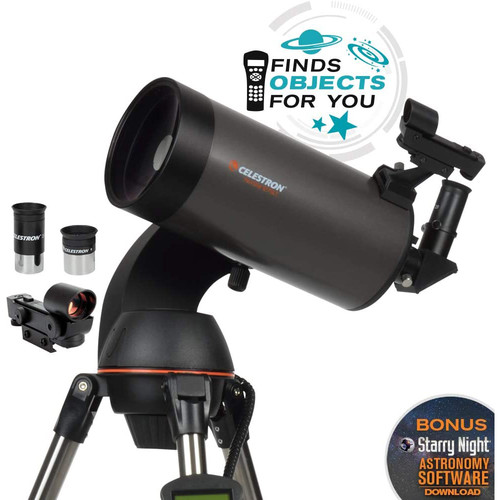
The Celestron NexStar GoTo mounts are powered by eight AA user-supplied batteries, or an optional AC adapter, making them perfect as a travel telescope.
With Celestron’s SkyAlign Technology, aligning your telescope is fast and easy. Simply input the date, time and location (the CPC models have built-in GPS that does this for you) and then align the telescope to three bright stars of your choosing.
You do not need to know the names of the stars, you can even pick the moon or bright planets. The NexStar computer system will automatically figure out which stars were chosen and then align the telescope.
The 127SLT’s diagonal is a prism, and a nice one at that – unlike the cheap diagonals supplied with many entry-level scopes which are cheap mirrors that aren’t very flat, which tend to offer dim and fuzzier images.
Pros:
- Super optical construction
- Very easy to operate with
- Compact and portable design
- Included needed additional accessories
- Suitable for lunar/planetary astrophotography
Cons:
- 8 AA batteries required but not included
- Tripod can be more stable
6. UncleHu 150EQ Newtonian Reflector Telescope
- 150mm Large-Aperture Newtonian Reflector — Bright, Detailed Views: This 150mm Newtonian reflector with a 650mm focal length gathers ample light to deliver sharp, high-contrast views of the Moon, planets, and deep-sky objects. It’s an excellent choice for beginners and families looking for a capable first telescope, while also offering performance that meets the needs of users seeking an upgrade. The sleek, modern design adds a refined touch to any observing setup.
- Equatorial Mount for Accurate Tracking — Fine RA/DEC Control: The equatorial (EQ) mount aligns with Earth’s rotation, enabling smoother and more intuitive tracking of celestial objects. The latitude adjustment screw helps you fine-tune the viewing angle, while dual slow-motion control cables allow precise Right Ascension and Declination adjustments to keep your target centered throughout your observation.
- Stable Stainless Steel Tripod with Counterweight: The reinforced stainless steel tripod provides rigid, low-vibration support with an adjustable height range of 48.4–66.2 in (123–168 cm) for users of all ages. The counterweight balances the telescope tube for steadier, clearer views. The accessory tray keeps your accessories organized and within easy reach.
- Portable Carrying Bag — Safe Storage & Travel-Ready Design: The padded carrying bag protects all components while keeping everything neatly organized for worry-free storage. Easy to carry, it’s great for backyard observing, camping trips, school events, and dark-sky adventures. Enjoy astronomy anywhere with a setup that travels as easily as you do.
- Complete Accessory Kit — Easy Setup & Versatile STEM Learning: This telescope includes a detailed printed manual and requires no tools for quick assembly. 25mm and 10mm eyepieces plus a 2× Barlow lens for 26×–130× magnification, allowing easy switching between wide-field views and detailed close-ups. (Notice: This telescope may include one of two eyepiece sets; both versions are fully tested and deliver the same optical performance.) The 5×24 finder scope helps you locate and center targets quickly, the moon filter reduces glare for improved lunar contrast, and the phone adapter lets you capture and share memorable moments. Everything you need to begin exploring the night sky is included.
The UncleHu 150EQ Newtonian Reflector Telescope delivers impressive aperture and optical power for its price class, making it a compelling entry-level choice for serious beginners and amateur astronomers. With a 150 mm (6″) primary mirror and 650 mm focal length, this reflector gathers plenty of light, producing bright, high-contrast views of the Moon, planets like Jupiter (including its larger moons), and even some brighter deep-sky objects under dark skies.
The included eyepieces and 2× Barlow lens offer a useful magnification range (around 26×–130×), allowing users to switch between wide-field and more detailed planetary views without needing many extra accessories.
A standout feature for the price is the equatorial mount with slow-motion controls, which lets observers track celestial objects more smoothly as Earth rotates — a big benefit when watching Jupiter drift across the eyepiece over time. The sturdy stainless-steel tripod and counterweight help stabilize the optical tube, reducing vibration and making it easier to keep targets centered during observation.
The package also includes handy extras like a moon filter to reduce glare, a phone adapter for casual astrophotography, and a portable carrying bag, which makes this scope versatile for backyard astronomy nights or even trips to darker skies.
That said, some users note that setups like this still require a bit of learning and patience, especially if you’re new to equatorial mounts and manual tracking. While the optics are solid for the price, better views of fainter deep-sky objects or fine planetary details will still benefit from aftermarket eyepieces and steadier mounts down the line.
Overall, the UncleHu 150EQ strikes a strong balance between performance, included accessories, and affordability, giving beginners a capable tool for exploring the night sky without immediately needing premium gear.
7. Celestron NexStar 8SE Computerized Telescope
- ADVANCED TECH MEETS ICONIC DESIGN: The NexStar 8SE pairs Celestron’s legendary orange tube with a fully computerized GoTo system—ideal for those ready to step up from manual scopes and explore more of the night sky with precision and ease.
- 8-INCH SCHMIDT-CASSEGRAIN OPTICS: The large 8" aperture gathers enough light to reveal fine lunar details, cloud bands on Jupiter, and deep-sky objects like galaxies and globular clusters—all in a compact, portable form factor.
- FULLY AUTOMATED GoTo MOUNT WITH NEXSTAR+ HAND CONTROL: Use the NexStar+ hand control to select from a 40,000+ object database. The computerized mount then automatically slews to your target and tracks it—no star charts or manual alignment needed.
- FAST & EASY ALIGNMENT WITH SKYALIGN TECHNOLOGY: SkyAlign gets you observing fast—just center any three bright stars or planets, even if you don’t know their names. The system then calculates your position and aligns the mount in minutes.
- COMPATIBLE WITH CELESTRON ACCESSORIES: Easily upgrade your setup with all our latest accessories to enhance automation, wireless control, or location accuracy as your skills grow.
The Celestron NexStar 8SE is widely regarded as one of the most powerful and versatile telescopes in Celestron’s popular NexStar SE lineup, combining a substantial 8-inch aperture with a fully computerized GoTo mount that’s ideal for serious visual observing.
The large 203 mm primary mirror gathers significantly more light than smaller scopes, producing bright, detailed views of the Moon, planets like Jupiter and Saturn, and even many deep-sky objects such as nebulae and bright galaxies under decent skies.
Its classic Schmidt-Cassegrain optical design with high-quality StarBright XLT coatings enhances contrast and sharpness, making targets stand out clearly in the eyepiece.
One of the 8SE’s biggest strengths is its computerized Alt-Az GoTo mount and hand controller, which contains a database of tens of thousands of celestial objects.
After a simple star alignment at the start of your session, the telescope can automatically locate and track planets, stars, clusters, and more — a huge advantage if you’re still learning the sky or want to jump straight into observing rather than searching manually.
While this capability makes it beginner-friendly, the scope’s performance also satisfies more experienced observers who appreciate the combination of automation and visual power.
That said, there are a couple of things to consider before you buy. Some reviewers note that the single-arm fork mount can feel a bit light for the weight of the 8″ tube, meaning that at very high magnifications or in breezy conditions you may notice slight vibrations — something to be mindful of if you’re pushing for fine detail views.
Additionally, the telescope relies on an external 12-V power source for extended sessions (AA battery power is an option but runs down quickly), so planning for power beyond the included setup is wise.
Overall, however, the NexStar 8SE remains a highly capable, portable, and automated telescope that excels at planetary and deep-sky observing for hobbyists ready to take their astronomical experience to the next level.
Best Telescope To See Jupiter - Buying Guide
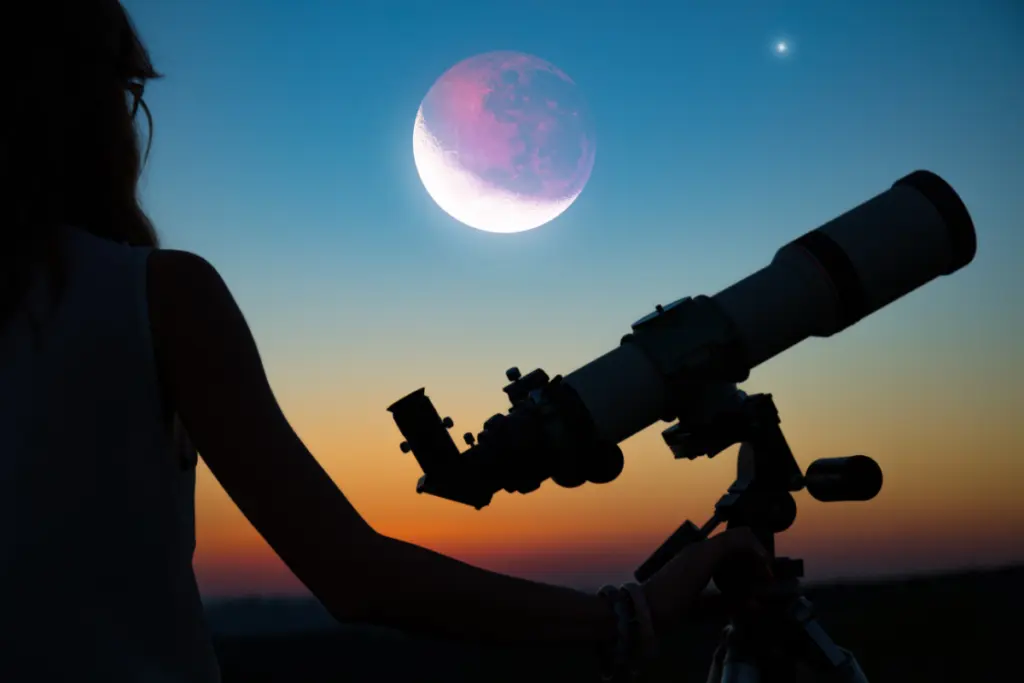
For a breathtaking planetary viewing experience every time, it is important to make sure you’re purchasing a quality product – not something you’ll find at most department-stores.
The telescope you want has two essentials: high-quality optics and a steady, smoothly working mount. You may also want the telescope to be nice and large, but don’t forget portability and convenience.
Features To Consider When Choosing A Good Telescope To See Jupiter
Aperture
The most important aspect of any telescope is its aperture, the diameter of its main optical component. A scope’s aperture determines both its light-gathering ability and its resolving power.
The aperture of a telescope is the diameter of the light collecting region, assuming that the light collecting region has a circular geometry . For an optical instrument, the aperture is the diameter of the objective lens (refracting telescope) or the primary mirror (reflecting telescope).
The larger the aperture, the more light the telescope can gather, and the fainter the limiting magnitude of the instrument. The field of view of the telescope decreases as the aperture increases, but the resolving power increases.
Focal Ratio
Focal ratio is the focal length divided by the objective diameter. A long focal ratio implies higher magnification and narrower field of view with a given eyepiece, which is great for observing the moon and planets and double stars.
For such objects, a focal ratio of f/10 or more is ideal. But if you want to see wide views of star clusters, galaxies, and the Milky Way through your telescope, then a lower focal ratio is better. You get less magnification, but you see more of the sky. Wide field telescopes have a focal ratio of f/7 or less.
Focal Length
The focal length is simply the effective distance from the lens or mirror to the focal point, where an eyepiece or camera would go.
Focal length is useful for two reasons: it’s the major determinant of useful magnification (which we’ll get onto in a moment) and it gives you a rough idea of what sort of field of view you can expect.
Smaller focal lengths deliver wider fields, so lean towards being better suited to observing large swathes of the night sky and for star hopping, while longer focal lengths offer narrower fields – perfect for planetary disc close-ups – and tend to allow you to use eyepieces with longer eye relief.
Accessories
A telescope is not a solitary object, and it needs many accessories to reach its full potential and unleash its A-game.
Mount & Base Support
First of all, mount and base support are the two most essential things required for the safe-keeping and proper functioning of a telescope.
Base support connects the actual telescope to the ground and creates a steady base. A mount is also an accessory that is vital to keep the telescope at its place for a peaceful trip on the outlook of space.
Tripod Stand
It is also crucial to determine the place where you plan on setting the telescope for good and choose the base support according to that spot, such as a window or floor. A tripod stand is the second most vital accessory that accompanies a telescope.
It is required to give length to the telescope so you can bring up the device to an appropriate height for a comfortable posture.
Apart from your comfort, a tripod stand also helps in keeping this delicate device steady on its grounds, so you don’t lose hundreds of dollars due to a slight nudge or a powerful breeze.
Carrying Bag
We discussed how important is portability when it comes to telescopes. It is one thing when a telescope can be converted into a compact device that can easily accompany you on your quest to view the Universe that exists beyond the limits of the naked eye.
A carrying bag specifically designed to hold up the telescope and all of its accessories safely is a lot of relief and a safe way to manage your device neatly.
Extra Eyepieces
Other accessories like an extra eyepiece or extra magnification lenses are also present, but they are not as essential as the ones mentioned above. But if you do manage to find a good deal where such accessories are also included in the package, then you can enjoy the majestic view with your special buddy simultaneously. As they say, the more, the merrier!
Conclusion
Our pick for the best computerized telescope to see Jupiter is the Celestron – NexStar 6SE.
Celestron‘s NexStar 6SE 150mm f/10 Schmidt-Cassegrain GoTo Telescope is a powerful, portable, and user-friendly Schmidt-Cassegrain-style scope that can be used for observing everything from the Moon and planets to deep-sky objects like stars, galaxies, and nebulae
Written by:

Chandrashekhara Rao
I grew up in a rural community with a dark sky, and that is where I learned to appreciate planets and stars at an early age. I have been fascinated with all things astronomical since I was a kid and started with a cheap-and-cheerful 60mm refractor on a wobbly tripod.
ABOUT US
We are a team of active amateur astronomers, here to help you with all your astronomy and science related needs – this is anything, from reviewing the latest telescopes to be released to talking about gravity and neurons. The Big Bang Optics was started because of our love for astronomy and to help others like us find the best telescope and accessories.
LEGAL DISCLAIMER
The Big Bang Optics is a participant in the Amazon Services LLC Associates Program, an affiliate advertising program designed to provide a means for sites to earn advertising fees by advertising and linking to Amazon.com. The Big Bang Optics also participates in affiliate programs with Clickbank and other sites. The Big Bang Optics is compensated for referring traffic and business to these companies.








